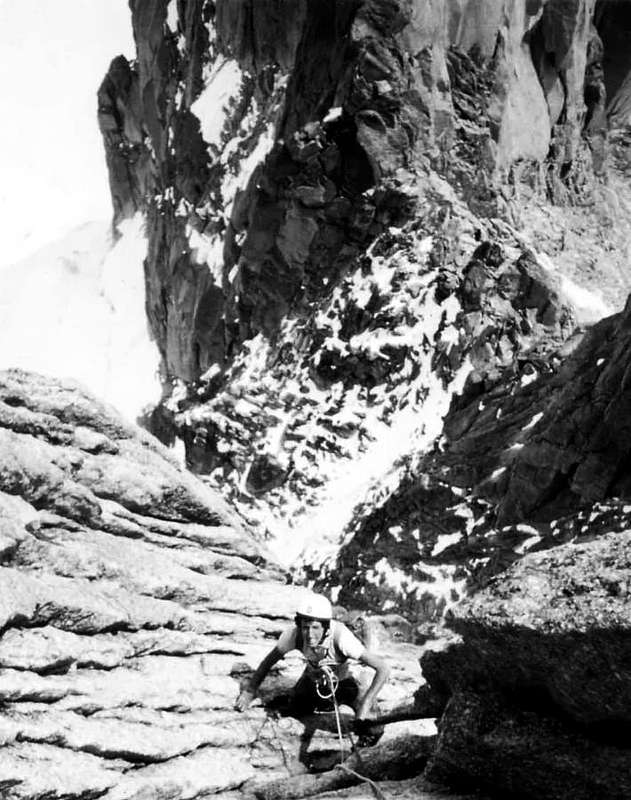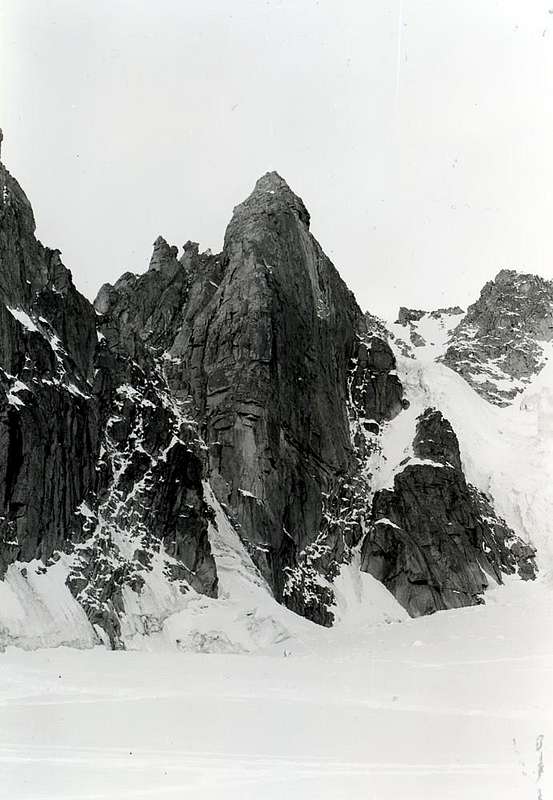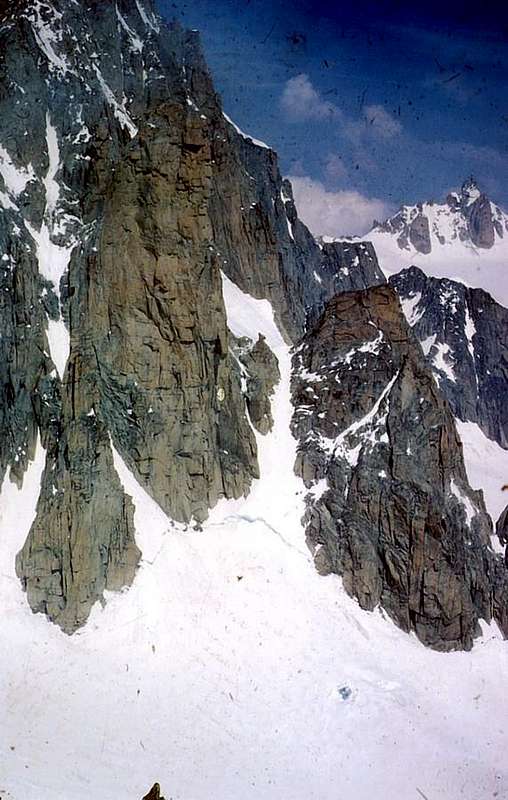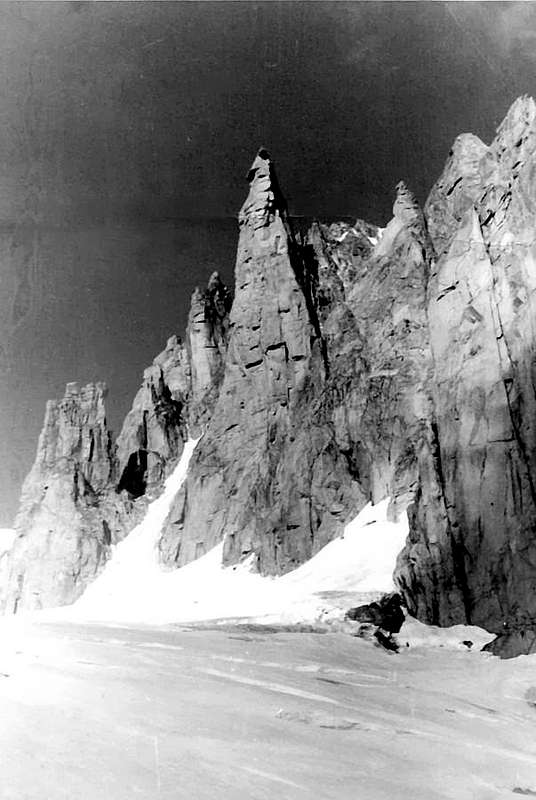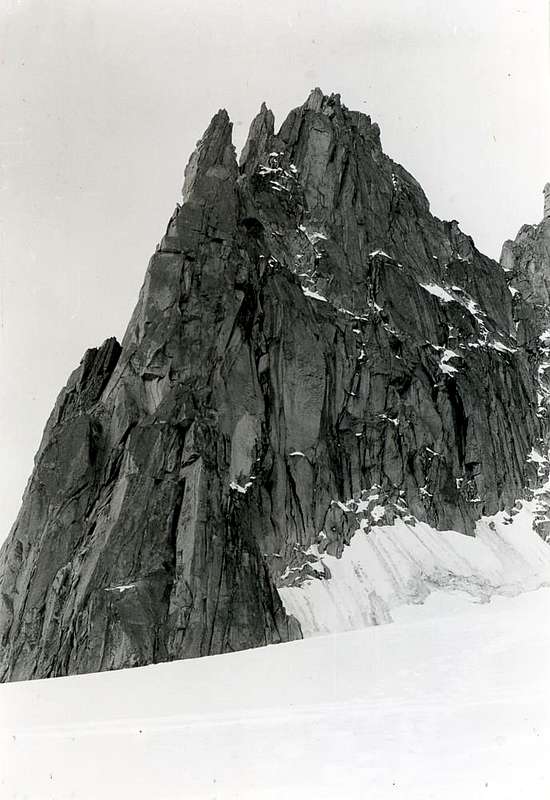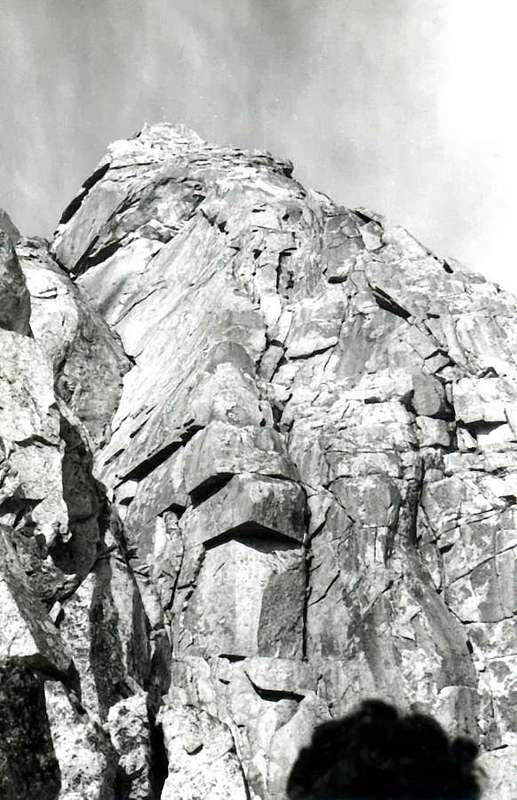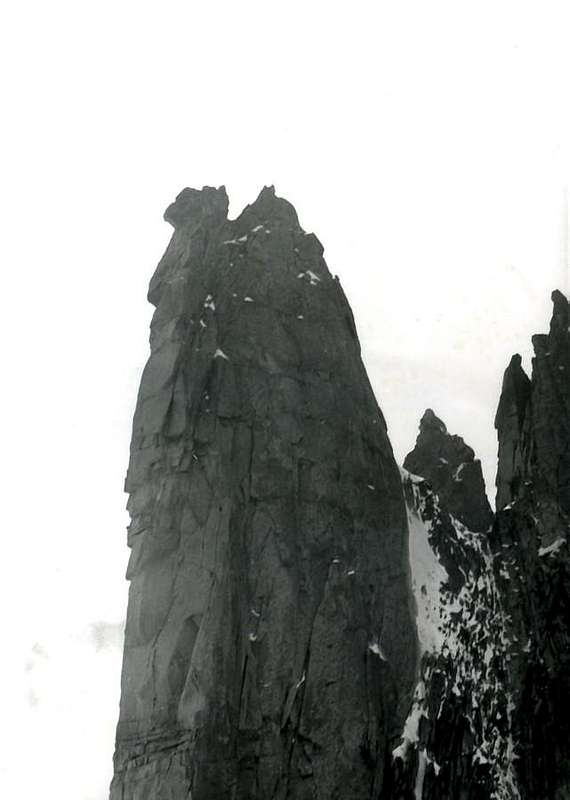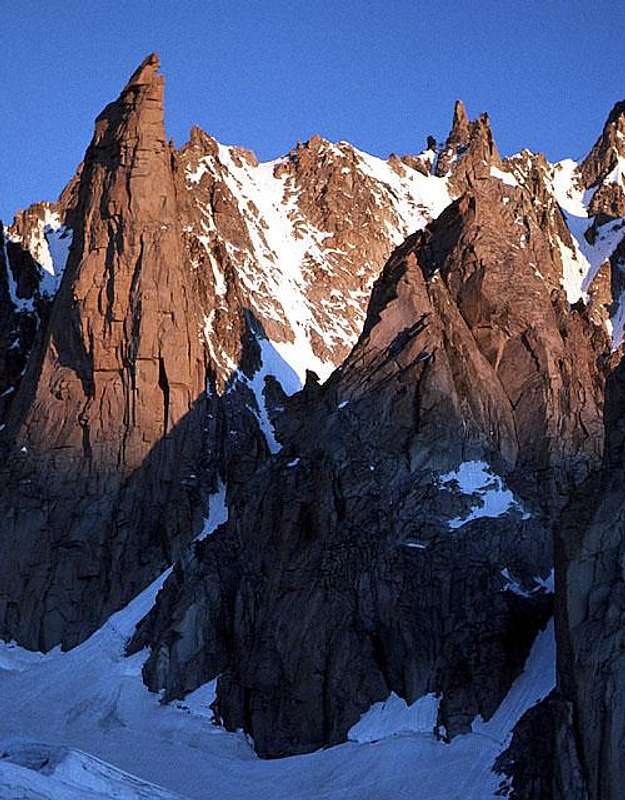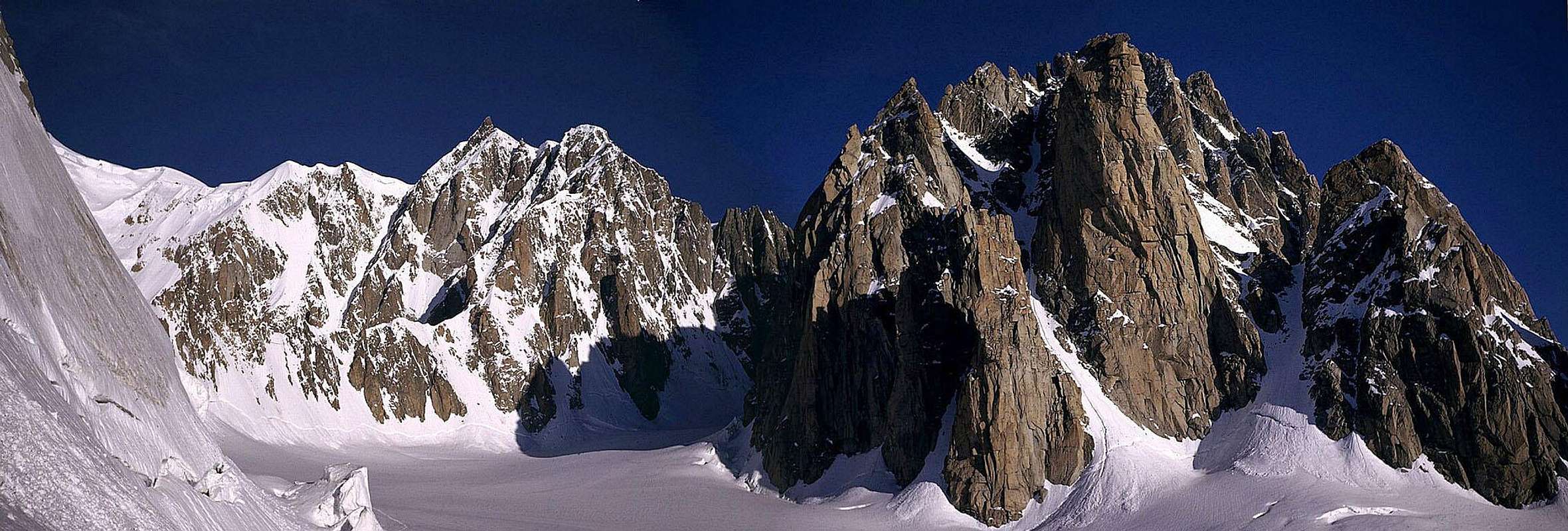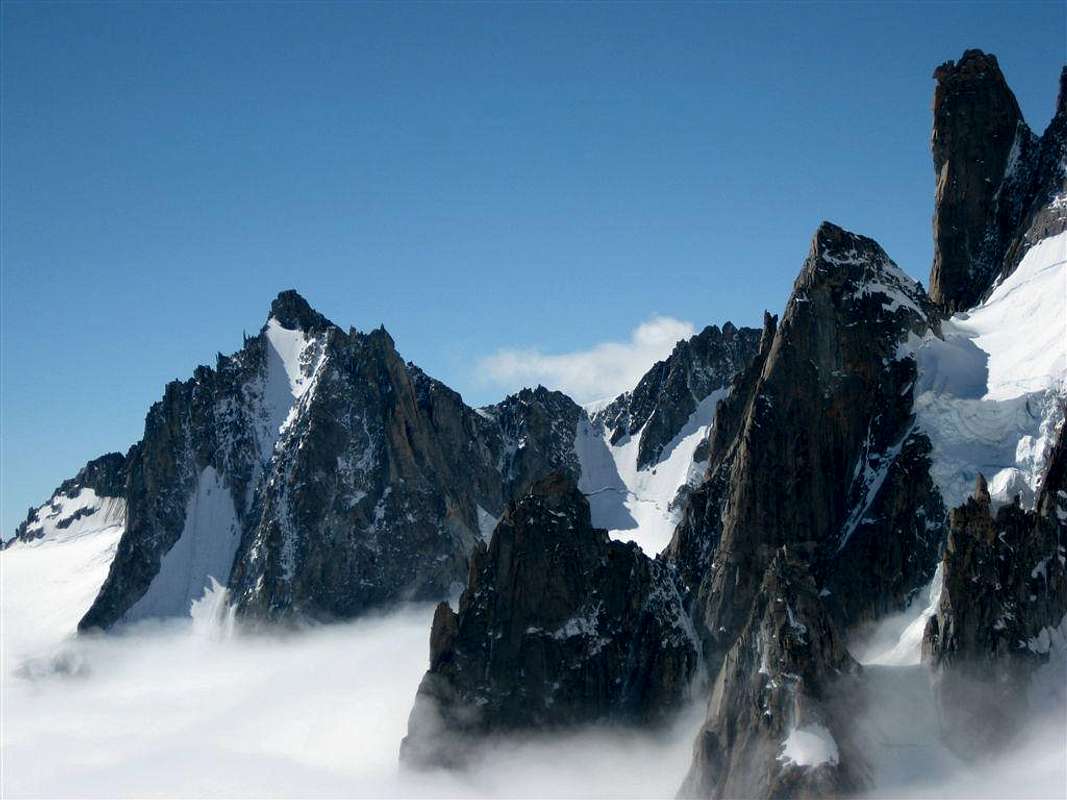The
"History Classic" of the two Capucins, at least as we understand it, begins with the conquest of the two absolute Summit and ends with the exploits of Walter Bonatti-Ghigo Luciano on 20th/23th, 1951 on the East Wall of the Grand; other companies have been accomplished but they belong to at least three different generations of Mountaineers: 1950-1970, 1990, and finally from this to this day. More specifically, we focus on the first, because, after this, the "bloom" cascade of journals and newspapers, to which we refer for more information, fuoriescon from our discourse and the specific intent of this article. In addition, the excessive placement of pitons (the same have known by now several works of "cleaning") as well as the modern "tricks & gimmicks" the Han made more attractive and accessible to a remarkable group of climbers falling in exactly the opposite to that which willed talk. The technical evolution has already begun on the Grand Capucin with its Walls East, North and South (1951, 1953 and 1956) continues on Petit, after the ascent of the North of this in 1953, and the neighboring Satellites such as Roi du Siam (
about 3650m; L and D. Baume with the strong Mountain Guide Courmayeur Arthur Ottoz in July 1952), the Pyramide with its Southeast and West Walls (
3468m; Piero Nava always with Arthur August 4th, 1953 with the first uphill and downhill through the other) and Northeast (Carlo Alberto Pinelli and Sabadini Carlo August 5th, 1958), the Chandelle (
3561m; Walter Bonatti with Engineer Roberto Gallieni 3th/4th August, 1960) as well as the Pic Adolphe Rey
(3535m. On this we find the climbs on the Edge West-northwest (Courmayeur Guides G. Lorenzi and Henry Junior Rey August 20th, 1951, down), the Spur of the South East Ridge (Busi Toni Francis Salluard September 6th, 1951) and Spur North East Ridge (Robert Guillaume and Lionel Terray September 15th, 1958. Another difficult ascent mainly with artificial climbing: August 12th, 1964 Aosta Valley Mountain Guides, by Aosta, Donnas and Valpelline, Angelo Bozzetti, Luigi Pramotton and Pietro "Piero" Rosset, go up to the Edge Southwest tracing a direct via to the Pic Adolphe. The same, marking the transition from the free climbing and more and more to the artificial ascent exceeds corners and crevices along the vertical wall situated between the East and West Edges (length 150 meters, of which about 100 in artificial nails used 90 especially in U and wedges. Difficulty TD +, with sections of artificial A3). In fact, by now these walls Satellites Tacul are become nearly of climbing gym.
But let's see about this in detail:
Petit Capucin (3693m)
is increased for the first time by Louis de Riseis with the two Mountain Guides Courmayeur Adolphe and Henry Rey August 25th, 1914 by the Brèche du Petit Capucin
(about 3590 metres), located at the foot of "The Carabinier"
(3612m), using the West Ridge, after climbing the Southeast Couloir that leads to this. On August 17th, 1929 is increased by means of the South Face by Gabriele Boccalatte and Renato Chabod; August 22th of the following year the French mountaineers Devies Lucien and Roger Devouassoux just open a way to the left. On August 9th, 1932 Corrado Alberico with Guido Derege and Massimo Mila, all by Turin, rise through the Eastern Couloir of the Brèche du Roi du Siam and the South Wall and, with more and more anti clockwise rotation in tracing the routes, August 16th, 1946 we have the ascent of the East Face by the
"three G" ie Giusto Gervasutti with Guido Arnoldi and Giuseppe Gagliardone. Inevitably, then it is up to the North, which will be the work of the Mountain Guides of Courmayeur Louis Glarey and Sergio Viotto at 6th/7th September, 1953, this latest venture somewhat challenging for the Period with steps of VI° and Artificial Climbing (up to A3 with the use of many wooden wedges), carried out by a promise of Mountaineering who died shortly after in the Rock Gym of the Mont Chétif near Courmayeur that now bears his name, on the great tower of the Becco dell'Aquila (Eagle Beak). Concerning the Winter the two Genoese climbers Enrico Cavalieri and Euro Mountain March 19th, 1957 carry the first winter at the Petit Capucin for the South Wall (Standard or Gabriele Boccalatte/Renato Chabod Via, August 17th, 1929), while for the first winter of the East Wall does not have news about. The same has been increased this season, but in other ways more "modern": in 1988 January 12th, by Gian Cesare Gariazzo and Gianni Lanza for the Northern Serac Petit Capucin; February 23th, by Gianni Lanza and Amabile Ramella realize from the Northeast via the "Goulotte Valeria", with itineraries that are completely outside of this dissertation.
Grand Capucin (3838m)
t's three Courmayeur Mountain Guides Adolphe and Henry Rey, Louis Lanier to accomplish this feat July 24th, 1924; the occasion of this
"daring climb" a pole was used in 10 meters of wood to which they had been applied to metal substrates. As they say Renato Chabod, Lorenzo Grivel and Silvio Saglio in their Guide C.A.I. 1963 Grand Capucin is like Don Quixote, Sancho Panza compared to the Petit and no ascent can be made to him without the use of artificial means. For any of his ways. The second climb, always using the same means, was built by Aimé Grivel with Eugène Hurzeler August 18th, 1929, while the third is the work of Giusto Gervasutti and Giorgio Salomone August 1st, 1946 with
"more orthodox methods and its 6° gr". After the fourth by Tom de Lépiney with Mountain Guide Lionel Terray in August of 1949, we have the rope Bonatti-Ghigo through East Wall, exploits that open the doors to another Era. Repeated on several occasions and by Gino Buscaini solo ascent in 1959, and in winter (by Gigi Alppi, Romano Merendi and Luciano Tenderini February 27th/29th 1959), promises to be the path of many other routes on its walls, among which are those of the North took place the 24th/25th July, 1955 by Lucien Berardini and Robert Paragot and that of the South of French climbers Claude Asper, Marcel Bron, Mario Grossi and Marcel Morel since 24th until 26th July, 1956.
![]() Capucins 1969,
Capucins 1969,
by Ilario Antonio Garzotto
La "Storia Classica" dei due Capucins, almeno come l'intendiamo noi, inizia con la conquista assoluta delle due Sommità e si conclude con l'exploit di Walter Bonatti-Luciano Ghigo del 20/23 Luglio 1951 sulla Parete Est del Grand Capucin; altre imprese sono state compiute ma appartengono ad almeno tre generazioni diverse di Alpinisti: dal 1950 al 1970, da questo al 1990 ed infine fino ai giorni nostri. Più specificatamente ci soffermiamo sulla prima, poiché, dopo questa, il "fiorire" a cascata di riviste specializzate, alle quali rimandiamo per saperne di più, fuoriescon dal nostro discorso e dagli intenti specifici di quest'articolo. Inoltre l'eccessivo posizionamento di chiodi (le medesime han conosciuto ormai diverse opere di "pulizia") nonché i moderni "artifizi & marchingegni" le han rese più appetibili ed accessibili ad una notevole schiera di arrampicatori ricadendo nel fattore esattamente opposto a quello del quale vuolsi discorrere. L'evoluzione tecnica già iniziata sul Grand Capucin con le sue Pareti Est, Nord e Sud (1951, 1953 e 1956) continua anche sul Petit, dopo la salita della Nord di questo nel 1953, e sui vicini Satelliti come il Roi du Siam (3650 metri circa; L e D. Baume con la forte Guida di Courmayeur Arthur Ottoz nel Luglio 1952), la Pyramide con le sue Pareti Sudest ed Ovest (3468 m; Piero Nava sempre con Arthur il 4 Agosto 1953 in salita con la prima e discesa tramite l'altra) e Nordest (Carlo Alberto Pinelli e Carlo Sabadini il 5 Agosto 1958), la Chandelle (3561 m; Walter Bonatti con Roberto Gallieni il 3/4 Agosto 1960) nonché sul Pic Adolphe (3535 m. Su questo troviamo le salite sullo Spigolo Ovest-nordovest (G. Lorenzi e Henry Rey Junior il 20 Agosto 1951, in discesa), lo Sperone Sud della Crestone Est (Toni Busi con Francis Salluard 6 Settembre 1951) e Sperone Nord della medesimo (Robert Guillaume e Lionel Terray il 15 Settembre 1958. Registriamo un'altra scalata (é il caso di dirlo visto l'uso pressocché continuo di staffe) prevalentemente con arrampicata artificiale: il 12 Agosto 1964, da parte delle Guide valdostane di Aosta, Donnas e Valpelline Angelo Bozzetti, Luigi Pramotton e Piero Rosset, con salita per lo spigolo Sud-Ovest tracciando una diretta al Pic Adolphe. La stessa, segnando sempre di più il passaggio tra l'arrampicata libera e quella artificiale, supera lungo diedri e fessure la parete verticale situata tra gli spigoli Sud-Ovest ed Ovest (lunghezza 150 metri, dei quali circa 100 in artificiale; utilizzati 90 chiodi specialmente a U e cunei. Difficoltà TD+, con tratti in artificiale di A3). Infatti ormai queste pareti dei Satelliti del Tacul son diventate quasi a tutti gli effetti delle palestre di roccia.
Ma vediamo in merito nel dettaglio:
Petit Capucin (3693 m)
Viene salito per la prima volta da parte di Luigi de Riseis con le due Guide di Courmayeur Adolphe ed Henry Rey il 25 Agosto 1914 dalla Brèche du Petit Capucin
(3590 metri circa), posta ai piedi di "Le Carabinier"
(3612 m), utilizzando la Cresta Ovest, dopo aver risalito il Couloir Sudest conducente a questa duplice forcella. Il 17 Agosto 1929 viene scalato per mezzo della Parete Sud da parte dei famosi Gabriele Boccalatte e Renato Chabod; il 22 di Agosto dell'anno successivo i francesi Lucien Devies e Roger Devouassoux aprono una via appena più a sinistra. Il 9 Agosto 1932 i torinesi Corrado Alberico con Guido Derege ed il Musicologo Massimo Mila salgono tramite il Canale Orientale della Brèche du Roi du Siam e la Parete Sud e, con rotazione sempre più anti oraria nella tracciatura degli itinerari, il 16 Agosto 1946 abbiamo la salita della Parete Est da parte dei "tre G" cioé Giusto Gervasutti con Guido Arnoldi e Giuseppe Gagliardone. Inevitabilmente quindi tocca alla Nord, che sarà opera delle Guide di "Courmayeurensi" Louis Glarey e Sergio Viotto il 6/7 Settembre 1953, impresa quest'ultima alquanto impegnativa per l'Epoca con passaggi di VI° e di Arrampicata in Artificiale (fino ad A3 con utilizzo di molti cunei in legno). Questa salita viene realizzata da una promessa dell'Alpinismo che morirà poco tempo dopo nella Palestra di Roccia, che oggi porta il suo nome, del Mont Chétif sul torrione del Becco dell'Aquila. Per quanto concerne l'Alpinismo Invernale i due genovesi Enrico Cavalieri e Euro Montagna il 19 Marzo 1957 realizzano la 1° invernale al Petit Capucin per la parete Sud (Via Normale o Boccalatte/Chabod 17 Agosto 1929), mentre per la prima invernale della Parete Est non s'hanno notizie in merito. Lo stesso é stato salito in questa stagione ma per altre vie più "moderne" ovvero il 12 Gennaio del 1988 da parte di Gian Cesare Gariazzo e Gianni Lanza per il Seracco a Nord del Petit Capucin; mentre il 23 febbraio dello stesso anno Gianni Lanza e Amabile Ramella realizzano da Nordest la via "Goulotte Valeria", con itinerari che esulano completamente dalla presente dissertazione.
Grand Capucin (3838m)
Son le tre Guide di Courmayeur Adolphe ed Henry Rey con Louis Lanier a compiere questa impresa il 24 Luglio 1924; nell'occasione di questa
"rocambolesca salita" venne utilizzata una pertica in legno di 10 metri alla quale erano stati applicati dei supporti metallici. Come dicono Renato Chabod, Lorenzo Grivel e Silvio Saglio nella loro Guida C.A.I. del 1963 il Grand Capucin é come Don Chisciotte rispetto al Sancho Panza del Petit e nessuna salita può essere a lui effettuata senza l'ausilio di mezzi artificiali. Per qualsiasi delle sue vie. La seconda ascensione, sempre tramite gli stessi mezzi, fu realizzata da Aimé Grivel con Eugène Hurzeler il 18 Agosto 1929, mentre la terza é opera di Giusto Gervasutti con Giorgio Salomone il 1 Agosto 1946 con
"metodi più ortodossi e relativo 6° gr.". Dopo la quarta di Tom de Lépiney con la Guida Lionel Terray nell'Agosto del 1949, abbiamo l'impresa di Bonatti-Ghigo sulla Parete Est, exploits che spalancano le porte ad un'altra Era. Ripetuta in molteplici occasioni e salita da Gino Buscaini in solitaria nel 1959 nonché in inverno (Gigi Alppi, Romano Merendi e Luciano Tenderini il 27/29 Febbraio 1959), preannuncia il tracciato di numerose altre vie sulle sue pareti, tra le quali citiamo quella della Nord avvenuta il 24/25 Luglio 1955 da parte di Lucien Berardini e Robert Paragot e quella della Sud di Claude Asper, Marcel Bron, Mario Grossi e Marcel Morel dal 24 al 26 Luglio 1956.
Eastern Via
That morning of August we had to go to the Matterhorn to make the Northwest Ridge or Zmutt. But time, which initially looks good, progressively worsens giving bad signals; so we change course and Switzerland are inclined to France, as the
"Cable car of the Glaciers" allows you to hop on and take altitude with greater speed. In Torino Old Refuge deliver some things to Aunt Hilary and then, from Punta Helbronner, directing us to, towards the Glacier du Géant, Little Capucin. Objective: The East Face of the Petit through the Via Gervasutti-Arnoldi-Gagliardone 1946. A classic. We will not be alone. But, being a few days before August Holiday, we do not find too many people either: a single group of roped climbers with three Frenchmen, one woman, and another two (you see them in the photo at the top and bottom of the attack of the crack/chimney) precede us. Because of a very thick fog, which comes from
"Valleé Blanche", we lose between the seracs, and then find, including a lightened and the other, the Capucin, above us with its high dome flaming; easily continue through broken rocks to the Brèche Pic Adolphe, where we arrived at 10h '30. We note already other mountaineers climbing on superb monolith. We leave for the delicate crossing on the North Slope of Brèche; 11 am and are fairly easily, lift some small rocks dirty ice, we are at the attack of the famous fifth slot with embedded block that, according to the C.A.I. Guide
"Mont Blanc Vol. I°", is very tiring. We did three pitches in the crossing and one uphill to the slot using a half now, there are three nails fixtures ((not that we use to gain time, as we do for the entire climb where incidentally there are not any more), but the passage, preventing the narrow chimney to fit with the whole body, it's really laboriously "atrocious". At one point the beak of the ax slips under the lock jammed, preventing me to continue: take off the bag, forget that I have slipped the ax without it being connected and I'm not done with the thought that it two jumps fly at the base, 150 metres below. hear only two
"din ... din". In three hours and 15 minutes of climbing very nice on 250 metres of III° and IV° along parallel cracks, cracked blocks and rocks with output over a long diagonal crack to the left we are on the aerial Summit, and comes to us is a
"yodeling" by three climbers who have climbed the Pic Adolphe through the Lionel Terray-Robert Guillaume September '58.
![]() Pic Adolphe Rey: North Wall & (to right) Brèche 1972,
Pic Adolphe Rey: North Wall & (to right) Brèche 1972,
by Marco Cossard
Another mountaineer, small point silhouetted against the blue of the sky, is following the last pitches of the Via Walter Bonatti/Luciano Ghigo 1950 on East Wall Grand Capucin. We leave at 15h '30', not so good for rocks and snowy, we arrive at the Brèche Petit Capucin/Le Carabinier and from this, by driving with snow under the ice after an abseil at the start, go down into quite steep Couloir des Capucins. We are based at 18h '45, while in this last stretch I had to put crampons because it was ice-glass or
"verglass". We are at the Rifugio Torino to 20h '15. Do not we have gone to look for my ice ax, since it is our intention to go up tomorrow the Pyramide du Tacul via the East Ridge, or Arthur Ottoz Route, and then, after the descent, go to the terminal crevasse of the North Wall of the Petit Capucin to see find the same. In the evening we sleep deliciously, but when we see that we get out of the shelter is rampant in bad weather and not be seen, due to the dense fog that most, an inch from his nose. We take our luggage and go down with two climbers Turin that have gone through the Tacul Pillar Gervasutti (realized by Piero Fornelli and Giovanni Mauro 29th/30th July 1951). Meanwhile, aunt Ilario at the shelter yesterday we learned that they are dead, only the Mount Blanc, seven people. It will be a thrilling downhill because the storm stops the cable car at the highest point; the same dangles dangerously under the lash of the wind and, after a good half hour, when we are organizing with others to join the ropes for an abseil of 100 metres, the same as the sudden starts doing pull us in a flash of lightning, a good sigh of relief. We know from the newspapers that the dead that Sunday in the mountains are more than twenty.
Better not complain too much, until you are flying only axes!
I wanted to tell this ascension, drawing from personal memories which unfortunately, or rather fortunately, are diluted more and more with the passage of time and leaning on my first Mountaineering Diary 1964-1970 and that of Ilario Antonio Garzotto (1964-1969 from which transcribe the report below), a companion of ascension of 62 Summit which unfortunately died fifty days following along with another close friend Gianni Junod on the Wall East-southeast of the Aiguille Jean Joseph Croux, Arthur Ottoz Route, always in the Chain of Mount Blanc. This could be a "Route", instead I wrote an "Article" with a specific purpose: to explain to young people what was still the mentality (completely wrong) in vogue in the Sixties, which then was the same as the Age of Giusto Gervasutti commonly known as
"Il Fortissimo" and Companions. Use a nail was almost a shame and you used it less and most were good;
"Safety" was donated to the use of the rope through the anchor to the rock spikes that typically offered and it is configured with the Technical and Personal Skills calling it with the term
"Subjective Security". Otherwise, if no, you risked. Maybe climbing simultaneously to save time. What happened: A minimum error or unexpected rock falls became fatal and without any possibility of "defense" or reaction with respect to the event. So I do not write to affirm our skill in climbing the East without a single nail and in full
"Free Climbing", as almost certainly did Giusto and his companions, but a warning to the young people inviting them to take care of before anything else:
"Security in the progression". Always necessary to bring home the backpack. You have to think about those who remain. Here begins the real TRAGEDY ...
![]() Frontally: Petit Capucin East Face 1969,
Frontally: Petit Capucin East Face 1969,
by Ilario Antonio Garzotto
Quella mattina d'Agosto dovevamo andare al Cervino a fare la Cresta Nordovest o di Zmutt. Ma il tempo, che inizialmente sembra buono, progressivamente peggiora dando brutti segnali; così cambiamo rotta e dalla Svizzera propendiamo per la Francia, visto che la "Funivia dei Ghiacciai" permette di salire e prendere altitudine con maggior velocità. Al Rifugio Torino Vecchio consegnamo alcune cose ad una zia di Ilario per poi, da Punta Helbronner, indirizzarci sul Ghiacciaio del Gigante verso i Capucin. Obiettivo: la Parete Est del Petit tramite la Via Gervasutti-Arnoldi-Gagliardone del 1946. Una classica. Non saremo soli. Ma, essendo pochi giorni prima di Ferragosto, ci stupiam di non trovar neppur troppa gente: una sola cordata di tre francesi, una donna, ed un'altra di due che ci precedono (li vedi in alto nella foto ed in basso all'attacco della fessura/camino). A causa d'una nebbia fittissima, proveniente dalla "Valleé Blanche", ci sperdiam tra i seracchi, per poi ritrovare, tra una schiarita e l'altra, il Capucin, che ci sovrasta con la sua alta cupola fiammeggiante; continuiamo facilmente per mezzo di rocce rotte fino alla Brèche del Pic Adolphe, dove arriviamo alle ore 10 e mezza. Notiam già altre cordate che arrampicano sul superbo monolite. Partiamo per la delicata traversata sul Versante Nord della Brèche; sono le ore 11 in punta ed abbastanza facilmente, risalite alcune roccette sporche di ghiaccio, siamo all'attacco della famosa fessura di V° con blocco incastrato che, a detta della Guida C.A.I. "Monte Bianco Vol. I°", é alquanto faticosa. Abbiamo fatto tre tiri di corda nella traversata ed uno in salita fino alla fessura impiegando mezz'ora; vi sono infissi tre chiodi (che non utilizziamo per guadagnar tempo, come faremo per l'intera salita dove daltronde non ce ne sono più), ma il passaggio, impedendo lo stretto camino d'inserirsi con tutto il corpo, é veramente "atroce". Ad un certo punto il becco della picca s'infila sotto il blocco incastrato impedendomi di proseguire e pur di scendere: con una "acrobazia contorsionistica" riesco a togliere il sacco; dimentico d'aver infilato la picca senza che questa fosse allacciata e non ho finito di pensarlo che questa con due salti vola alla base, 150 metri sotto. Sento sol due tintinnanti "din ... din". In 3h '15 d'arrampicata molto bella su 250 metri di III° e IV° lungo fessure parallele, per blocchi e rocce fessurate con l'uscita tramite una più lunga e obliqua a sinistra siamo sull'aerea Sommità del Petit Capucin, mentre ci arriva un bello "jodel" da parte di tre alpinisti che son saliti al Pic Adolphe tramite la Via Lionel Terray/Robert Guillaume (del 15 Settembre 1958). Un altro alpinista, puntino stagliato sulla verticalità di sinistra contro l'azzurro del cielo, sta percorrendo gli ultimi tiri della Via Walter Bonatti/Luciano Ghigo alla Est del Grand Capucin.
![]() Outline left: Grand Capucin East Bonatti Via 1969,
Outline left: Grand Capucin East Bonatti Via 1969,
by Ilario Antonio Garzotto
Ripartiamo alle 15h '30 e, per rocce non molto buone ed innevate, arriviamo alla Brèche Petit Capucin/Carabinier e da questa, tramite neve marcia con sotto del ghiaccio, dopo una corda doppia all'inizio, scendiamo il discretamente ripido Couloir des Capucins. Siamo alla base alle 18h '45, mentre in quest'ultimo tratto ho dovuto mettere i ramponi perché era in ghiaccio-vetro. Siamo al Rifugio Torino alle 20 '15. Non siamo passati a cercare la mia piccozza, poiché é nostra intenzione di salire domani la Pyramide du Tacul tramite la Cresta Est, o Via Arthur Ottoz, e quindi, dopo la discesa, andare alla crepaccia terminale della Parete Nord del Petit per veder di ritrovar la medesima. La sera dormiamo gustosamente, ma allorché ci alziamo constatiamo che fuori imperversa il brutto e non si vede, causa la nebbia più che fitta, ad un palmo dal naso. Prendiamo i bagagli e scendiamo con due torinesi che han salito il Tacul pel Pilier Gervasutti (realizzato da Piero Fornelli/Giovanni Mauro il 29/30 Luglio 1951). Nel frattempo dalla zia d'Ilario al rifugio abbiam appreso che ieri son morte, solo sul Bianco, sette persone. Sarà discesa thrilling perché il temporale blocca la funivia nel punto più elevato; la stessa dondola qua e là e sù e giù pericolosamente sotto le sferzate del vento e, dopo buona mezz'ora, quando stiam organizzando cogl'altri d'unir le corde per una doppia di quasi 100 metri, la stessa d'improvviso riparte facendoci tirar, tra lampeggiar di fulmini, un buon sospiro di sollievo. Sapremo dai giornali che i morti di quella scovolgente domenica in montagna son più di venti.
Meglio non lamentarsi troppo, sinché a volar dabbasso son soltanto le piccozze!
Ho voluto raccontar di questa ascensione, traendo dai ricordi personali che purtroppo o, meglio per fortuna, si diluiscono sempre di più col passar del tempo ed appoggiandomi al mio primo Diario Alpinistico 1964-1970 nonché a quello di Ilario Antonio Garzotto (1964-1969, dal quale trascriverò la relazione in calce), compagno di ascensione su 62 Sommità che purtroppo morirà cinquanta giorni appresso insieme all'altro amico fraterno Gianni Junod sulla Parete E-SE della Aiguille Jean Joseph Croux, Via Arthur Ottoz, sempre nella Catena del Monte Bianco. Questa poteva essere una "Route", invece ho scritto un'"Article" con obiettivo ben preciso: spiegare ai più giovani qual fosse ancora la mentalità (completamente sbagliata) in auge negli Anni Sessanta, che poi era la medesima dell'Era del Giusto Gervasutti "Il Fortissimo" e Compagni. Utilizzare un chiodo era quasi onta e meno ne usavi e più bravo eri; la
"Sicurezza" era devoluta all'utilizzo della corda tramite l'ancoraggio agli spuntoni che la roccia offriva ed in genere la si configurava con la Tecnica e le Abilità personali chiamandola con il termine di
"Soggettiva". Altrimenti, in assenza, rischiavi. Magari arrampicando simultaneamente per guadagnare del tempo. Quello che avvenne: un minimo errore od inaspettata caduta di pietre diventava fatale. Quindi non scrivo per affermar della nostra bravura nel salir la Est senza neppur infigger o usar chiodo ed in piena
"Arrampicata Libera", come quasi sicuramente fecero Giusto e compagni, bensì per effettuare un monito ai giovani invitandoli a curarsi prima d'ogni altra cosa della
"Sicurezza nella progressione". Sempre bisogna riportare a casa lo zaino. E poi si deve pensar a chi resta. Che lì inizia, purtroppo, la vera TRAGEDIA ...
In full by the Mountaineering Diary 1964-69 Ilario Antonio Garzotto
"From the Rifugio Torino (9.00) bring us up under the Petit Capucin, then continue easily to the Brèche Pic Adolphe account at the Petit Capucin (10.30). We start at 11.00 and go down a few meter on the North side and we crossed a gully icy. We attack the East Wall (11.30 three pitches). Go up a chimney (5° tiring) and continue for parallel slits that allow a nice climbing (4°). Pass a red slab for a slot on the its left side and continue to rock cracked up under the Summit, go out on the Top for a diagonal crack to the left (14.45). Leave again at 15.30 and at 18.45 we are at the base of the gully between the two Capucins. we are back at the Torino Refuge 20.15, where we stop to sleep. (hours spent on the wall 3.30).".
![]()
"Dal Rifugio Torino (9.00.) ci portiamo fin sotto al Petit Capucin, poi continuiamo facilmente verso la Brèche del Pic Adolphe, contro al Petit Capucin (ore 10.30). Partiamo alle 11.00, scendiamo per qualche metro sul versante Nord e traversiamo un canalino ghiacciato. Siamo all'attacco della Parete Est (ore 11.30, tre tiri di corda). Risaliamo un camino (5° faticoso) e continuiamo per fessure parallele che consentono una bella arrampicata (4°). Superiamo una placca rossa per una fessura sul suo lato sinistro e continuiamo per rocce fessurate fin sotto la Vetta. Usciamo in Vetta per una fessura obliqua verso sinistra (ore 14.45). Ripartiamo alle 15.30 ed alle 18.45 siamo alla base del colatoio tra i due Capucins. Siamo di ritorno al Rifugio Torino alle 20.15, dove ci fermiamo a dormire. (ore impiegate per la parete 3.30)." Looking everywhere "in the round"
![]() The both from Southeast 1969,
The both from Southeast 1969,
by Ilario Antonio Garzotto
![]() The both from Northeast 2004,
The both from Northeast 2004,
by gabrieleIn SP see Petit Capucin by Tom Fralich, gabriele & Grand Capucin by Rahel Maria Liu, Antonio Giani, hiltrud.liu
![]() Always from complete Southeast above the "Cirque Maudit", Glacier du Géant & "Valleé Blanche" 2007,
Always from complete Southeast above the "Cirque Maudit", Glacier du Géant & "Valleé Blanche" 2007,
by Gabriele Roth aka gabriele
![]() All Routes on Eastern & Northern Walls 2009,
All Routes on Eastern & Northern Walls 2009,
by Antonio Giani
![]() Falling to the left from the Western ... with view from North 2007,
Falling to the left from the Western ... with view from North 2007,
by Rahel Maria Liu Mont Blanc & Capucins Books
BOOKS:
- "Guida delle Alpi Occidentali" by Giovanni Bobba and Luigi Vaccarone C.A.I. Section Turin Vol. II° (parte II), 25 May 1896.
- Guidebook Vallot "Monte Bianco (1), sectors: Mount Blanc, Vallée Blanche, Aiguilles de Chamonix; Edit. in Rome by Edizioni Mediterranee, 1978.
- "80 itinerari di escursionismo alpinismo sci alpinismo in valle d'aosta" by Osvaldo Cardellina Edit. Musumeci in Aosta, June 1977 (various editions in Italian and French).
- "Diario Alpinistico di Ilario Antonio Garzotto 1964-1969" Mountain Diary by Ilario Antonio Garzotto (unpublished).
- "Diario Alpinistico Osvaldo Cardellina" M. Diary 1964-1970 by O. Cardellina and other various Diaries with Table of Contents for the detailed Climbs 1964-2013 (unpubl.).
- Guida dei Monti d'Italia "Monte Bianco Volume I" with the attached color Map 1:50.000, by Renato Chabod, Lorenzo Grivel and Silvio Saglio - C.A.I./T.C.I., Edit. Milan 1963.
- "Scalate nelle Alpi" by Giusto Gervasutti, with various Editions: Edit. in Turin by Il Verdone, 1945, S.E.I. 1961 and CDA & Vivalda, 2005,
- "Le Mie Montagne", by Walter Bonatti, Edit. Zanichelli in Bologna 1961.
- "I giorni grandi" by Walter Bonatti, Edit. in Milan by Arnoldo Mondadori Editore, 1972 (reprint by Edit. Zanichelli in 1978).
Comments
No comments posted yet.
